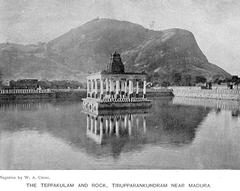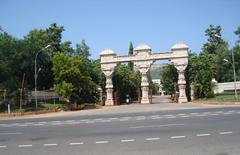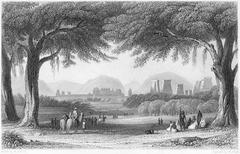
Thirupparamkunram Murugan Temple: Visiting Hours, Tickets, and Historical Significance
Date: 16/08/2024
Introduction
The Thirupparamkunram Murugan Temple, situated near Madurai in Tamil Nadu, India, stands as a testament to South India’s rich historical and religious heritage. As one of the six principal abodes of Lord Murugan, the temple is not only a revered pilgrimage site but also an architectural marvel. Its origins trace back to the 6th century CE during the Pandya dynasty, with further enhancements by the Nayak rulers (templeyatri.in). The temple is renowned for its unique rock-cut architecture, blending Dravidian and Nayak styles, and houses idols of multiple deities, including a rare face-to-face positioning of Lord Shiva and Lord Vishnu (maduraitourism.co.in). This comprehensive guide aims to delve into the temple’s historical significance, architectural features, and practical visitor information, offering a rich and immersive experience for spiritual seekers and history enthusiasts alike.
Table of Contents
History of Thirupparamkunram Murugan Temple
Origins and Construction
The Thirupparamkunram Murugan Temple, located in Madurai, Tamil Nadu, is one of the oldest and most revered temples in South India. Its origins date back to the 6th century CE, during the reign of the Pandya kings. The temple is believed to have been constructed during this period, making it a significant historical and cultural landmark. The roots of the temple can be traced even further back to the Sangam period, which adds to its historical richness and importance (templeyatri.in).
Architectural Evolution
Over the centuries, the Thirupparamkunram Murugan Temple has undergone several renovations and additions, each contributing to its grandeur. The temple’s architecture is a blend of Dravidian and Nayak styles, characterized by intricate carvings and sculptures that adorn its walls and pillars. The entrance tower, known as the gopuram, stands tall and majestic, showcasing the craftsmanship and artistic prowess of ancient artisans (templeyatri.in).
Mythological Significance
The temple holds immense mythological significance, particularly in relation to Lord Murugan, also known as Kartikeya or Skanda. According to Hindu mythology, Lord Murugan is the son of Lord Shiva and Goddess Parvati and is revered as the deity of war and victory. One of the most popular legends associated with the temple is the slaying of the demon Surapadman by Lord Murugan. It is believed that this epic battle took place at Thirupparamkunram, where Lord Murugan emerged victorious, thus establishing his divine powers and supremacy (templeyatri.in).
Historical Events and Renovations
The temple has witnessed numerous historical events and renovations over the centuries. During the 8th century, under the Pandyan reign, the temple saw significant architectural developments, including the carving of its main shrine out of a rock. This period also saw the addition of separate shrines for other deities such as Lord Shiva, Lord Vishnu, Goddess Durga, and Lord Vinayaka (maduraitourism.co.in).
The Nayak rulers, who came into power later, further enhanced the temple’s architectural splendor by constructing massive mandapams (pillared halls) such as the Aasthaana Mandapam, Kambathadi Mandapam, Maha-mandapam, and Ardha Mandapam. These mandapams are adorned with exquisitely carved pillars, showcasing the artistic excellence of the Nayak period (maduraitourism.co.in).
Unique Architectural Features
One of the unique architectural features of the Thirupparamkunram Murugan Temple is the presence of idols of Lord Shiva and Lord Vishnu facing each other, which is a rare occurrence in Hindu temples. This unique aspect adds to the temple’s historical and religious significance. Additionally, the temple’s innermost shrine, carved out of a rock, consists of sanctums for various deities, including Lord Shiva, Lord Vishnu, Lord Vinayaka, Lord Subramanya, and Goddess Durga. The intricate carvings on the walls of the Parankundram rock present an enthralling and intricate craftsmanship that existed during the Pandyan period (maduraitourism.co.in).
Legends and Mythology
The temple is steeped in legends and mythology that add to its allure. Another popular legend associated with the temple is the story of Lord Murugan’s marriage to Deivanai, the daughter of Indra, the king of gods. It is believed that the celestial wedding took place at Thirupparamkunram, and the temple serves as a reminder of this divine union. This legend further enhances the temple’s significance as a sacred site for marriages, with many couples seeking the blessings of Lord Murugan for a happy and successful married life (templeyatri.in).
Cultural and Religious Importance
The Thirupparamkunram Murugan Temple is not only a place of worship but also a cultural and religious hub. The temple’s annual festival, Skanda Sashti, celebrated in the Tamil month of Aippasi (October/November), commemorates Lord Murugan’s victory over the demon Surapadman. This six-day festival draws thousands of devotees from all over the country, creating a vibrant and spiritual atmosphere (templeyatri.in).
Rock-Cut Architecture
One of the highlights of the temple is the rock-cut shrine dedicated to Goddess Durga. Carved out of a single rock, this shrine is a fine example of ancient rock-cut architecture and is believed to have been built during the Pallava period. The shrine adds another layer of historical significance to the temple, showcasing the architectural ingenuity of ancient Indian artisans (templeyatri.in).
Historical Artifacts and Sculptures
The temple’s sanctums are adorned with beautifully carved sculptures depicting various deities and mythological scenes. The intricate workmanship and attention to detail are evident in every aspect of the temple’s architecture. The pillars, adorned with intricate carvings, are a visual delight, showcasing the mastery of ancient artisans. Additionally, the temple houses a magnificent statue of Nandi, Mayil, and the vehicle Mouse, which have been artistically carved and are located in front of the Kodi Maram (maduraitourism.co.in).
Visitor Information
Visiting Hours
The Thirupparamkunram Murugan Temple is open to visitors every day from 5:30 AM to 1:00 PM and from 4:00 PM to 9:00 PM. Early morning and evening are the best times to visit to experience the serene ambiance and participate in the poojas (rituals). Special poojas and events may have different timings, so it is advisable to check in advance.
Ticket Prices
Entry to the temple is generally free. However, there may be charges for special poojas, offerings, and guided tours. Donations are also welcome and go towards the maintenance and development of the temple.
Travel Tips
- Footwear: Visitors are required to remove their footwear before entering the temple premises. It is recommended to wear easily removable shoes.
- Dress Code: Modest attire is encouraged when visiting the temple. Traditional Indian clothing is ideal.
- Photography: Photography inside the main sanctum is usually prohibited. However, taking pictures in the outer areas and temple surroundings is allowed.
- Guided Tours: Consider hiring a local guide for a more insightful experience, as they can provide historical context and explain the significance of various rituals and structures.
Nearby Attractions
- Meenakshi Amman Temple: Another renowned temple in Madurai, known for its stunning architecture and rich history.
- Gandhi Memorial Museum: A museum dedicated to Mahatma Gandhi, showcasing his life and contributions to India’s independence.
- Azhagar Kovil: A temple dedicated to Lord Vishnu, located at the foothills of the Alagar Hills.
Accessibility
The temple is generally accessible to all visitors. However, the inner sanctum and certain areas may have steps and uneven surfaces, which could be challenging for those with mobility issues. Wheelchair access is limited, but assistance is usually available upon request.
FAQ
Q: Are there any specific days when the temple is closed? A: The temple is open every day of the year. However, visiting hours may vary on special occasions and festival days.
Q: Can I book a guided tour in advance? A: Yes, guided tours can often be booked in advance through local tour operators or directly at the temple office.
Q: Is there a place to store my belongings? A: There are usually designated areas for storing footwear and personal items outside the temple premises.
Q: Are there any special events I should be aware of? A: The annual Skanda Sashti festival is a major event that attracts thousands of devotees. It is a vibrant and spiritually enriching experience worth attending.
Conclusion
The Thirupparamkunram Murugan Temple stands as a testament to the rich cultural and historical heritage of Tamil Nadu. Its origins, architectural evolution, mythological significance, and unique features make it a must-visit destination for spiritual seekers and history enthusiasts alike. The temple’s blend of Dravidian and Nayak architectural styles, coupled with its rock-cut shrines and intricate carvings, offer a glimpse into the artistic and architectural prowess of ancient India. The legends and festivals associated with the temple further enhance its cultural and religious importance, making it a true gem of Tamil Nadu (templeyatri.in, maduraitourism.co.in).
References
- Temple Yatri. (n.d.). Thirupparamkunram Murugan Temple. Retrieved from https://templeyatri.in/information/aarupadai-veedu/thirupparamkunram-murugan-temple/
- Madurai Tourism. (n.d.). Thirupparamkunram Murugan Temple. Retrieved from https://maduraitourism.co.in/thiruparankundram-murugan-temple-madurai
- Prem Bhakti. (n.d.). Thirupparamkunram Murugan Temple. Retrieved from https://www.prembhakti.in/en/temples/thirupparamkunram-murugan-temple-thiruparankundram-tamil-nadu/history-significance-architecture
- Outlook Traveller. (n.d.). Thiruparankundram Hills. Retrieved from https://www.outlooktraveller.com/experiences/spiritual/madurais-thiruparankundram-hills-stand-as-confluence-of-religions
- Temple Knowledge. (n.d.). Thirupparamkunram Murugan Temple. Retrieved from https://templeknowledge.com/thiruparankundram-murugan-temple-dress-code-architecture-history/
- Agate Travel. (n.d.). Thirupparamkunram Murugan Temple. Retrieved from https://www.agatetravel.com/thiruparankundram-murugan-temple-madurai-india.html
- Wikipedia. (n.d.). Subramaniya Swamy Temple, Thiruparankundram. Retrieved from https://en.wikipedia.org/wiki/Subramaniya_Swamy_Temple,_Thiruparankundram
- Temple Purohit. (n.d.). Thirupparamkunram Murugan Temple. Retrieved from https://www.templepurohit.com/hindu-temple/thirupparamkunram-murugan-temple/
- Trans India Travels. (n.d.). Thirupparamkunram Murugan Temple. Retrieved from https://www.transindiatravels.com/tamil-nadu/madurai/thiruparankundram-murugan-temple/



